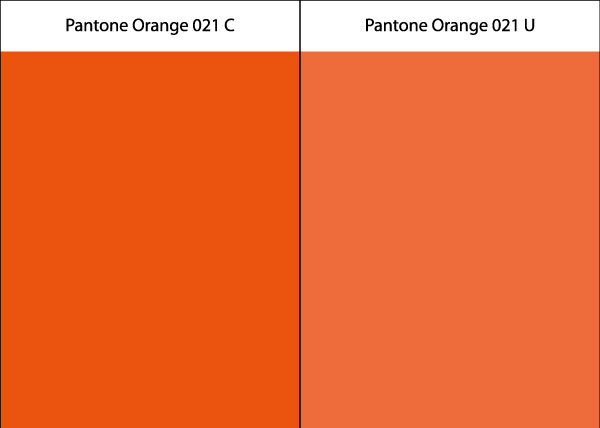Pantone is a standardized color matching system. Pantone colors are identified by a unique code that helps ensure consistency in color reproduction across different mediums and printing processes.
Pantone has two different color books: Pantone Coated and Pantone Uncoated.
The primary reason that digital ink swatches are labeled with “uncoated” or “coated” are to provide an approximate reference for how a specific color will appear on different styles of paper.
Pantone Coated (C)– Coated stands for laminated paper which helps display brighter and more saturated colors.
Pantone Uncoated (U)– Unlaminated paper lets the color soak into the paper, so the colors appear less bright and a bit more organic.
The terms ‘coated’ and ‘uncoated’ refer to the paper characteristics on which the colors are printed, not ink. Ink itself is not coated or uncoated. The ink formula that printers use is the same regardless of whether we’re using a coated or an uncoated swatch book.
The same PANTONE color printed on coated and uncoated paper will have quite a different visual appearance.
A specific Pantone ink formula will look very different on different kinds of paper and can affect the end-color. Ink on a brown kraft paper will look different than on a bright white sheet. This is surprising how different an ink can look based on the paper color.
Also color on screen can look completely different when it’s printed.

The important thing to know up front is that you can’t print colors accurately using RGB or HEX colors. RGB and HEX are color models that are used only on screens, because they’re created using light. On the other hand, Pantone and CMYK colors are made using ink pigments. What’s possible with light and what’s possible with ink are completely different, and that’s why it’s important to design for production using Pantone or CMYK colors from the start.
While both Pantone and CMYK can achieve accurate color reproduction, Pantone colors tend to be more precise and consistent because they are based on pre-mixed ink formulas. CMYK colors, on the other hand, can vary depending on the printer, ink, and paper used, which can result in color shifts and inconsistencies.
You can read more about CMYK here: https://designpack.com.ee/cmyk/
